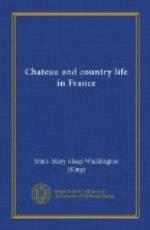The Abbe came back to the chateau to dine, but he couldn’t get away until he had seen his Sisters and harmonium packed safely into the big omnibus and started for La Ferte. It looked so pretty all the way home. It was quite dark, and the various groups were struggling down the hill and along the road, their lanterns making a bright spot on the snow; the little childish voices talking, laughing, and little bands running backward and forward, some disappearing at a turn of the road, the lantern getting dimmer, and finally vanishing behind the trees. We went very slowly, as the roads were dreadfully slippery, and had a running escort all the way to the Mill of Bourneville, with an accompaniment of drums and trumpets. The melancholy plains of the Valois were transformed tonight. In every direction we saw little twinkling lights, as the various bands separated and struck off across the fields to some lonely farm or mill. It is a lonely, desolate country—all great stretches of fields and plains, with a far-away blue line of forests. We often drive for miles without meeting a vehicle of any kind, and there are such distances between the little hamlets and isolated farms that one is almost uncomfortable in the absolute solitude. In winter no one is working in the fields and one never hears a sound; a dog’s bark is welcome—it means life and movement somewhere.
[Illustration: There was some poor old woman still gazing spellbound.]
It is quite the country of the “haute culture,” which Cherbuliez wrote about in his famous novel, “La Ferme du Choquart.” The farms are often most picturesque—have been “abbayes” and monasteries. The massive round towers, great gate-ways, and arched windows still remain; occasionally, too, parts of a solid wall. There is a fine old ruin—the “Commanderie,” near Montigny, one of our poor little villages. It belonged to the Knights Templars, and is most interesting. The chapel walls are still intact, and the beautiful roof and high, narrow windows. It is now, alas! a “poulailler” (chicken-house), and turkeys and chickens are perched on the rafters and great beams that still support the roof. The dwelling-house, too, is most interesting with its thick gray walls, high narrow windows, and steep winding staircase. I was always told there were “donjons” in the cellars, but I never had the courage to go down the dark, damp, slippery staircase.
We were quite glad to get back to our big drawing-room with the fire and the tea-table; for of course the drawback to our entertainment was the stuffiness (not to say bad smell) of the little room. When all the children and grown people got inmost of them with damp clothes and shoes-the odour was something awful. Of course no window could be opened on account of the candles, and the atmosphere was terrible. At the end, when it was complicated with wine and cake and all the little ones’ faces smeared with chocolate and “dragees,” I really don’t know how we stood it.




